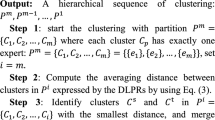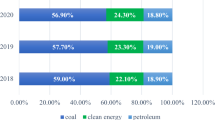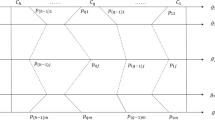Abstract
Public–private partnership is a form of contract that the government regards private sectors as long-term partners in infrastructures and public services. With increasing intercity travel passengers, the intercity railway PPP projects have attracted more and more attention. The PPP model selection is a complex decision problem for PPP project construction. It usually requires many experts from different fields to be involved in project process, which belongs to a large-scale group decision making (LSGDM) problem. Therefore, a trust-based LSGDM consensus reaching framework is proposed for intercity railway PPP model selection. Firstly, this paper develops a new clustering algorithm by considering the direct trust relationship and the opinion deviation. Based on the trust value between experts within subgroups, a trust consensus model to obtain stable trust relationships is built. Then, the weights associated with experts and subgroups are calculated. Furthermore, minimum adjustment models for different opinion consensus levels are built to improve the opinion consensus of subgroups. Finally, Hangzhou-Shaoxing-Taizhou intercity railway PPP model selection problem is offered to show the effectiveness of the new approach, and comparative analysis is conducted.





Similar content being viewed by others
References
Ou XQ, Zhang GH, Chang XY (2016) Renewal and development of intercity passenger rail system: a case of China. Transp Res Rec 2546(1):53–59
The State Council of the People’s Republic of China (2021) Outline of the 14th Five-Year Plan (2021–2025) for national economic and social development and vision 2035 of the People's Republic of China. Retrieved from http://www.gov.cn/xinwen/2021-03/13/content_5592681.htm. Accessed 13 December 2021
Zhang S, Chan APC, Feng YB, Duan HX, Ke YJ (2016) Critical review on PPP research – A search from the Chinese and international journals. Int J Proj Manag 34(4):597–612
Wong ELY, Yeoh EK, Chau PYK, Yam CHK, Cheung AWL, Fung H (2015) How shall we examine and learn about public-private partnerships (PPPs) in the health sector? Realist evaluation of PPPs in Hong Kong. Soc Sci Med 147:261–269
Tang BW, Xu J, Sun YZ, Zhou N, Shen B, Liao SY, Liu YL (2019) Policy solution and game analysis for addressing the challenge of developing public-private partnership energy project. Environ Res Lett. https://doi.org/10.1088/1748-9326/ab0217
Tang YR, Liu MD, Zhang B (2021) Can public-private partnerships (PPPs) improve the environmental performance of urban sewage treatment? J Environ Manage. https://doi.org/10.1016/j.jenvman.2021.112660
National Development and Reform Commission (2015) Implementation opinions on further encouraging and expanding social capital investment in railway construction. Retrieved from https://www.ndrc.gov.cn/fggz/zcssfz/zcgh/201507/t20150729_1145695.html?code=&state=123. Accessed 13 December 2021
National Development and reform Commission (2020) Implementation opinions on supporting private enterprises to participate in the construction and development of transportation infrastructure. Retrieved from https://www.ndrc.gov.cn/xxgk/zcfb/tz/202007/t20200708_1233392.html?code=&state=123. Accessed 13 December 2021
Zhao N, Ying F (2018) Method selection: a conceptual framework for public sector PPP selection. Built Environ Proj A 9(2):214–232
Villalba-Romero F, Liyanage C (2016) Implications of the use of different payment models: the context of PPP road projects in the UK. Int J Manag Proj Bus 9(1):11–32
Zhang CL, Liang YZ, Huang Z, Qiao HJ, Zhang S (2019) Selection of PPP program models based on ecological compensation in the Chishui watershed. Water Policy 21(3):582–601
Bai WLYS, Zhang L (2020) How to finance for establishing hydrogen refueling stations in China? An analysis based on fuzzy AHP and PROMETHEE. Int J Hydrogen Energ 45(59):34354–34370
Zhao H, Zhang JQ, Ge YY (2021) Operation mode selection of NIMBY facility public private partnership projects. PLoS ONE. https://doi.org/10.1371/journal.pone.0254046
Nguyen LC, Notteboom T (2017) Public-private partnership model selection for dry port development: an application to Vietnam. World Review of Intermodal Transportation Research 6(3):229–250
Meng FY, Tang J, Zhang SL, Xu YY (2020) Public-private partnership decision making based on correlation coefficients of single-valued neutrosophic hesitant fuzzy sets. Informatica-Lithuan 31(2):359–397
Liu BS, Shen YH, Chen XH, Chen Y, Wang XQ (2014) A partial binary tree DEA-DA cyclic classification model for decision makers in complex multi-attribute large-group interval-valued intuitionistic fuzzy decision-making problems. Inf Fusion 18:119–130
Xu XH, Du ZJ, Chen XH, Cai CG (2019) Confidence consensus-based model for large-scale group decision making: a novel approach to managing non-cooperative behaviors. Inf Sci 477:410–427
Dunn JC (1973) A fuzzy relative of the ISODATA process and its use in detecting compact well-separated clusters. Cybern Syst 3(3):32–57
Baraldi A, Blonda P (1999) A survey of fuzzy clustering algorithms for pattern recognition. I. IEEE Trans Syst Man Cybern B Cybern 29(6): 778–785
Zhang T, Ramakrishnan R, Livny M (1996) BIRCH: an efficient data clustering method for very large databases. ACM SIGMOD Rec 25(2):103–114
Herrera-Viedma E, Cabrerizo FJ, Kacprzyk J, Pedrycz W (2014) A review of soft consensus models in a fuzzy environment. Inf Fusion 17:4–13
Ding RX, Palomares I, Wang XQ, Yang GR, Liu BS, Dong YC, Herrera-Viedma E, Herrera F (2020) Large-scale decision-making: characterization, taxonomy, challenges and future directions from an artificial intelligence and applications perspective. Inf Fusion 59:84–102
Wu J, Chiclana F, Fujita H, Herrera-Viedma E (2017) A visual interaction consensus model for social network group decision making with trust propagation. Knowl Based Syst 122:39–50
Wu J, Wang S, Chiclana F, Herrera-Viedma E (2021) Two-fold personalized feedback mechanism for social network consensus by uninorm interval trust propagation. IEEE Trans Cybern. https://doi.org/10.1109/TCYB.2021.3076420
Liu BS, Zhou Q, Ding RX, Palomares I, Herrera F (2019) Large-scale group decision making model based on social network analysis: trust relationship-based conflict detection and elimination. Eur J Oper Res 275(2):737–754
Wu T, Zhang K, Liu XW, Cao CY (2019) A two-stage social trust network partition model for large-scale group decision-making problems. Knowl Based Syst 163:632–643
Xu XH, Zhang QH, Chen XH (2020) Consensus-based non-cooperative behaviors management in large-group emergency decision-making considering experts’ trust relations and preference risks. Knowl Based Syst. https://doi.org/10.1016/j.knosys.2019.105108
Du ZJ, Luo HY, Lin XD, Yu SM (2020) A trust-similarity analysis-based clustering method for large-scale group decision-making under a social network. Inf Fusion 63:13–29
Zhang HJ, Zhao SH, Kou G, Li CC, Dong YC, Herrera F (2020) An overview on feedback mechanisms with minimum adjustment or cost in consensus reaching in group decision making: research paradigms and challenges. Inf Fusion 60:65–79
Yuan YX, Cheng D, Zhou ZL (2021) A minimum adjustment consensus framework with compromise limits for social network group decision making under incomplete information. Inf Sci 549:249–268
Du ZJ, Yu SM, Luo HY, Lin XD (2021) Consensus convergence in large-group social network environment: coordination between trust relationship and opinion similarity. Knowl Based Syst. https://doi.org/10.1016/j.knosys.2021.106828
Tian ZP, Nie RX, Wang JQ (2019) Social network analysis-based consensus-supporting framework for large-scale group decision-making with incomplete interval type-2 fuzzy information. Inf Sci 502:446–471
Chu JF, Wang YM, Liu XW, Liu YC (2020) Social network community analysis based large-scale group decision making approach with incomplete fuzzy preference relations. Inf Fusion 60:98–120
Li SL, Wei CP (2020) A two-stage dynamic influence model-achieving decision-making consensus within large scale groups operating with incomplete information. Knowl Based Syst. https://doi.org/10.1016/j.knosys.2019.105132
Gao PQ, Hung J, Xu YJ (2020) A k-core decomposition-based opinion leaders identifying method and clustering-based consensus model for large-scale group decision making. Comput Ind Eng. https://doi.org/10.1016/j.cie.2020.106842
Lu YL, Xu YJ, Herrera-Viedma E, Han YF (2021) Consensus of large-scale group decision making in social network: the minimum cost model based on robust optimization. Inf Sci 547:910–930
Yu SM, Du ZJ, Zhang XY, Luo HY, Lin XD (2021) Punishment-driven consensus reaching model in social network large-scale decision-making with application to social capital selection. Appl Soft Comput. https://doi.org/10.1016/j.asoc.2021.107912
Dabarera GKM, Perera BAKS, Rodrigo MNN (2019) Suitability of public-private-partnership procurement method for road projects in Sri Lanka. Built Environ Proj A 9(2):199–221
Cherkos FD, Jha KN, Singh A (2020) Framework to select public-private partnership modalities. J Leg Aff Dispute Re. https://doi.org/10.1061/(ASCE)LA.1943-4170.0000425
Scott J (1988) Social network analysis. Sociology 22:109–127
Wasserman S, Faust K (1994) Social network analysis: methods and applications. Cambridge University Press, New York
Zhang HJ, Palomares I, Dong YC, Wang WW (2018) Managing non-cooperative behaviors in consensus-based multiple attribute group decision making: an approach based on social network analysis. Knowl Based Syst 162:29–45
Wu J, Zhao ZW, Sun Q, Fujita H (2021) A maximum self-esteem degree based feedback mechanism for group consensus reaching with the distributed linguistic trust propagation in social network. Inf Fusion 67:80–93
Zadeh LA (1975) The concept of a linguistic variable and its application to approximate reasoning-I. Inf Sci 8:199–249
Xu ZS (2004) EOWA and EOWG operators for aggregating linguistic labels based on linguistic preference relations. Int J Uncertain Fuzz 12(6):791–810
Rodriguez RM, Martinez L, Herrera F (2012) Hesitant fuzzy linguistic term sets for decision making. IEEE T Fuzzy Syst 20(1):109–119
Zhang HM (2014) Linguistic intuitionistic fuzzy sets and application in MAGDM. J Appl Math. https://doi.org/10.1155/2014/432092
Zhang GQ, Dong YC, Xu YF (2014) Consistency and consensus measures for linguistic preference relations based on distribution assessments. Inf Fusion 17:46–55
Yao SB (2018) A new distance-based consensus reaching model for multi-attribute group decision-making with linguistic distribution assessments. Int J Comput Int Sys 12(1):395–409
Rodriguez A, Laio A (2014) Clustering by fast search and find of density peaks. Science 344(6191):1492–1496
Tan X, Zhu JJ, Cabrerizo FJ, Herrera-Viedma E (2021) A cyclic dynamic trust-based consensus model for large-scale group decision making with probabilistic linguistic information. Appl Soft Comput. https://doi.org/10.1016/j.asoc.2020.106937
Wu J, Dai LF, Chiclana F, Fujita H, Herrera-Viedma E (2018) A minimum adjustment cost feedback mechanism based consensus model for group decision making under social network with distributed linguistic trust. Inf Fusion 41:232–242
Palomares I, Martinez L, Herrera F (2014) A consensus model to detect and manage noncooperative behaviors in large-scale group decision making. IEEE T Fuzzy Syst 22(3):516–530
Tang M, Liao HC, Mi XM, Lev B, Pedrycz W (2021) A hierarchical consensus reaching process for group decision making with noncooperative behaviors. Eur J Oper Res 293(2):632–642
Wu J, Chiclana F, Herrera-Viedma E (2015) Trust based consensus model for social network in an incomplete linguistic information context. Appl Soft Comput 35:827–839
Kamis NH, Chiclana F, Levesley J (2019) An influence-driven feedback system for preference similarity network clustering based consensus group decision making model. Inf Fusion 52:257–267
Kahneman D, Tversky A (1979) Prospect theory: an analysis of decision under risk. Econometrica 47(2):263–292
Loomes G, Sugden R (1982) Regret theory: an alternative theory of rational choice under uncertainty. Econ J 92(368):805–824
Bell DE (1982) Regret in decision making under uncertainty. Oper Res 30(5):961–981
Bell DE (1985) Disappointment in decision making under uncertainty. Oper Res 33(1):1–27
Bindhu V, Ranganathan G (2021) Hyperspectral image processing in internet of things model using clustering algorithm. J ISMAC 3(2):163–175
Chen JIZ, Hengjinda P (2021) Enhanced dragonfly algorithm based K-medoid clustering model for VANET. J ISMAC 3(1):50–59
Acknowledgements
This work was supported by the Major Project for National Natural Science Foundation of China (No. 72091515).
Author information
Authors and Affiliations
Ethics declarations
Conflict of interest
We declare that we have no conflict of interest.
Additional information
Publisher's Note
Springer Nature remains neutral with regard to jurisdictional claims in published maps and institutional affiliations.
Rights and permissions
About this article
Cite this article
Meng, F., Chen, B. & Wang, Z. A trust-based large-scale group decision making consensus reaching framework for intercity railway public–private partnership model selection. Neural Comput & Applic 34, 19091–19115 (2022). https://doi.org/10.1007/s00521-022-07462-4
Received:
Accepted:
Published:
Issue Date:
DOI: https://doi.org/10.1007/s00521-022-07462-4




